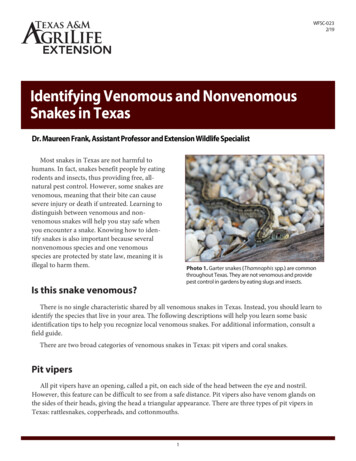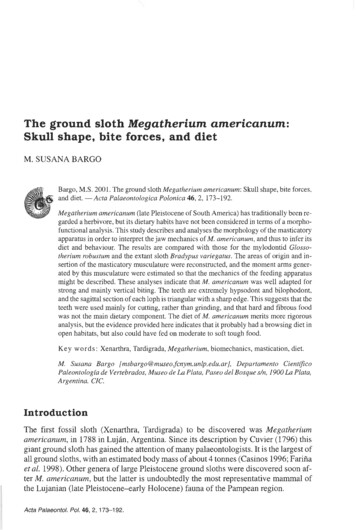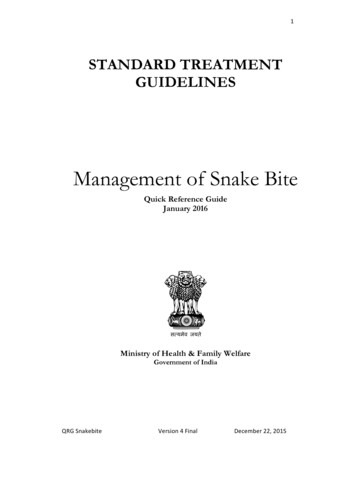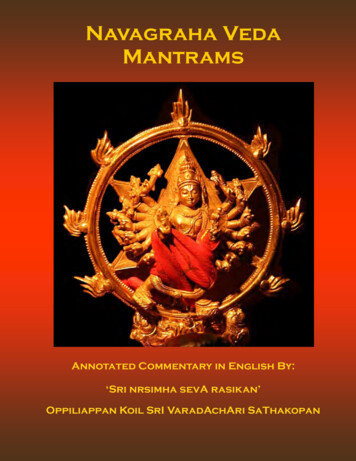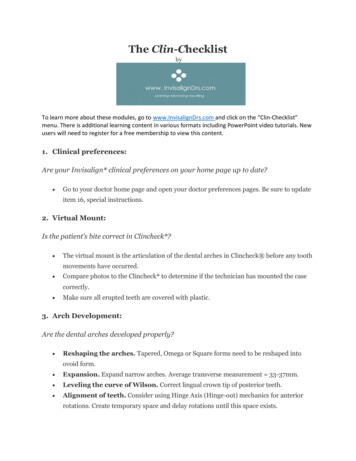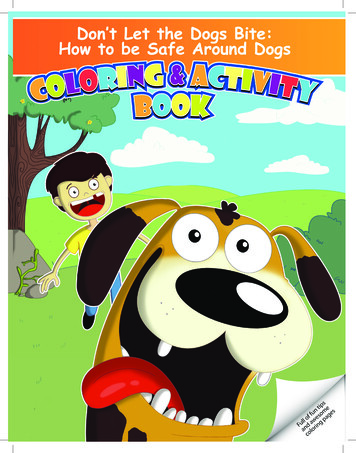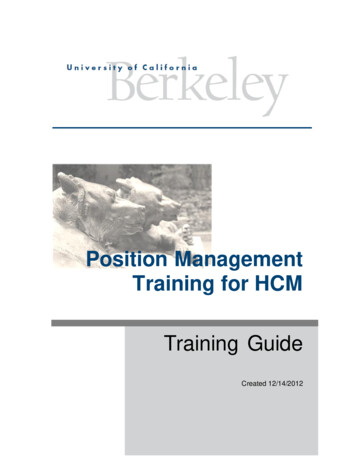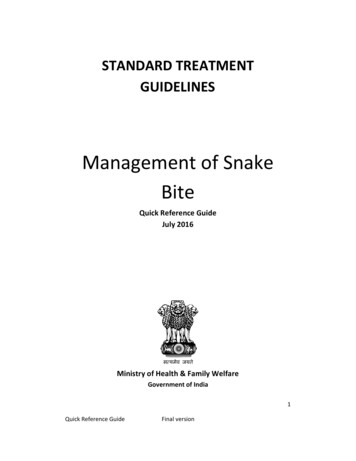
Transcription
STANDARD TREATMENTGUIDELINESManagement of SnakeBiteQuick Reference GuideJuly 2016Ministry of Health & Family WelfareGovernment of India1Quick Reference GuideFinal version
Table of Content1.INTRODUCTION . 42.INCIDENCE OF SNAKE BITE IN INDIA . 53.WHEN TO SUSPECT/RECOGNIZE SNAKEBITE. 64.RECOMMENDATIONS . 74.1 FIRST AID MEASURES . 74.2 SIGN & SYMPTOMS . 104.2.1 Asymptomatic (i.e., non Venom related symptoms) . 114.2.2 Dry Bite . 124.2.3 Neuroparalytic (Progressive weakness; Elapid envenomation) . 124.2.4 Vasculotoxic (haemotoxic or Bleeding) . 134.2.5 Locked in syndrome (LIS) . 154.2.6 Life threatening complications . 154.2.6 Painful Progressive Swelling (PPS). 174.2.7 Myotoxic . 174.2.8 Occult snakebite . 174.3. ASSESSMENT . 184.3.1 Critical Arrival: Patient assessment on arrival . 184.3.2 Patient assessment: . 204.4 LAB INVESTIGATIONS. 214.4.1 Bedside 20 minute whole blood clotting test (20 WBCT). 214.4.5- Rationale and interpretation of the tests . 245.ANTI SNAKE VENOM (ASV) THERAPY . 255.1 ANTISNAKE VENOM (ASV) . 265.2 ANTISNAKE VENOM (ASV) DOSE . 265.3 MONITORING OF PATIENTS AND PRECAUTIONS DURING ASV ADMINISTRATION . 275.4 ASV DOSE IN PREGNANCY. 285.5 ASV DOSE IN CHILDREN. 285.6 ASV DOSAGE IN VICTIMS REQUIRING LIFE SAVING SURGERY . 295.7 REPEAT DOSE OF ASV. 295.9 VICTIMS WHO ARRIVE LATE . 295.10. ASV REACTION . 306.MANAGEMENT NEUROTOXIC (NEUROPARALYTIC) ENVENOMATION . 327.MANAGEMENT OF VASCULOTOXIC SNAKEBITE . 347.1 VOLUME REPLACEMENT IN SNAKE BITE: . 347.2 FORCED ALKALINE DIURESIS (FAD) . 342Quick Reference GuideFinal version
7.6 IN CASE OF SHOCK, MYOCARDIAL DAMAGE . 368.MANAGEMENT OF SEVERE LOCAL ENVENOMING . 379.RECOVERY PHASE . 3810.OTHER MEASURES . 3910.1 SURGICAL PROCEDURES IN SNAKEBITE. 3910.1.1 Debridement of necrotic tissue . 3910.1.2 Compartmental syndrome . 4010.1.3 Criteria for fasciotomy in snakebite limb . 4011.DISCHARGE . 4111.1 FOLLOW-UP . 4111.2 REHABILITATION . 4112.REFERRAL CRITERIA . 4213.REFERENCES. 45ANNEXURE 1. SNAKE BITE EXAMINATION PERFORMA . 48ANNEXURE 2. SNAKE BITE MANGEMENT DIFFERENT LEVELS OF HEALTHCARE . 503Quick Reference GuideFinal version
1. IntroductionSnakebite is an acute life threatening time limiting medical emergency. It is apreventable public health hazard often faced by rural population in tropicaland subtropical countries with heavy rainfall and humid climate. There aremore than 2000 species of snakes in the world and about 300 species arefound in India out of which 52 are venomous. The venomous snakes found inIndia belong to three families Elapidae, Viperidae and hydrophinae (SeaSnakes). The most common Indian elapids are Naja naja (Indian Cobra) andBungarus caeruleus (Indian Krait), Daboia russalii (Russells’ Viper) and Echiscarinatus (Saw scaled viper) (Alirol et al 2010). Clinical effects of envenomingby same species of snake are almost similar except a few regional variations.Kraits are active during night hours, often biting a person sleeping on floor bed.Maximum Viper and Cobra bites occur during the day or early darkness, whilewatering the plantation or walking bare foot in grown grass or soybean crops.Although total number of bites may be more than 5-6 lakhs but only 30% arevenomous bites. On the basis of Million Death Study), non-fatal bites may be ashigh as 1.4 million per year. Though snakebite is a life threatening centuries oldcondition, it was included in the list of neglected tropical diseases (Warrell andWHO 2009; Bawaskar HS 2014). With its triad of high mortality, high disability,and substantial psychological morbidity, snake bite warrants high priorityresearch (lancet 2015).Currently, treatment quality is highly varied, ranging from good quality in someareas, to very poor quality treatment in others. The high fatality due to Kraitbite is attributed to the non-availability of antisnake venom (ASV), delayed andinappropriate administration of ASV, lack of standard protocol formanagement and inexperienced doctors and non-availability of ventilator orbag and valve (Bawaskar et al 2008). In India, there has always been a crisis ofantivenom supply (Bawaskar HS and Bawaskar PH 2001). On one hand there isshortage of ASV but on the other hand scarce ASV is being wasted due toexcessive dosage of ASV in the absence of a Standard Treatment Guideline.Victims are not only misdiagnosed as - abdominal colic, and vomiting due toindigestion, appendicitis, stroke, head injury, ischemic heart disease, foodpoisoning, trismus, hysteria and Guillain-Barre syndrome but also subjected tounnecessary investigations including MRI scans of the brain and lumbar4Quick Reference GuideFinal version
puncture thus causing undue delay in ASV therapy. Delayed administration ofASV or waiting until victim develops systemic manifestations i.e., a 6 h waitresults in systemic envenoming and high fatality (Bawaskar et al 2008).Morbidity and mortality depends on the age and size of victim (children receivelarger envenomation relative to body size), co-morbid conditions (elderlypatients succumb more easily to snake venom) as well as nature of first aidgiven. Factors not contributing to outcome are size of the snake and time ofbite (day/night)2. Incidence of Snake Bite in IndiaThere is a huge gap between the number of snakebite deaths reported fromdirect survey and official data. Only 7.23% snakebite deaths were officiallyreported (Majumdar, 2014 and Mohapatra 2011). Earlier hospital basedreports estimated about 1,300 to 50,000 annual deaths from snakebites peryear in India. Mohapatra et al, 2011, reported direct estimates from a nationalmortality survey of 1.1 million homes in 2001–03. The study found 562 deaths(0.47% of total deaths) were assigned to snakebites, mostly in rural areas, andmore commonly among males than females and peaking at ages 15–29. Thisproportion represents about 45,900 annual snakebite deaths nationally or anannual age-standardized rate of 4.1/100,000, with higher rates in rural areas(5.4) and with the highest rate in the state of Andhra Pradesh (6.2). Annualsnakebite deaths were greatest in the states of Uttar Pradesh (8,700), AndhraPradesh (5,200), and Bihar (4,500). Other Indian states with high incidence ofsnakebites cases are Tamil Nadu, West Bengal, Maharashtra and Kerala.Because a large proportion of global totals of snakebites arise from India,global snakebite totals might also be underestimated (Mohapatra et al 2011).In a retrospective study conducted in one district of West Bengal only 22.19% of thesnakebite victims attended the hospitals (Majumder et al, 2014). This isbecause even today most of the victims initially approach traditional healersfor treatment and many are not even registered in the hospital. Singh et alreported among the snakebite victims, about 60.76% received first aid at thesite of incident, and 20.25% of them sought hospital care after consulting thetraditional healers (ozhas, or mantrik and tandrik). Time lapsed for seekinghospital treatment was less than 4 h in 55.69% of the cases and more than 12 h5Quick Reference GuideFinal version
in 7.59% of the cases. Most (41.79%) patients were frightened, but no local orsystemic symptoms had appeared when they reported the emergency (Singh Aet al 2015).3. WHEN TO SUSPECT/RECOGNIZE SNAKEBITECLINICAL PRESENTATION:Clinical presentation of snakebite victim depends upon species of snake,amount of venom injected, season of the bite, whether snake is fed or unfed,site of bite, area covered or uncovered, dry or incomplete bite, multiple bites,venom injection in vessel, weight of the victim and time elapsed between thebite and administration of ASV. Venom concentration and constitutiondepends on environmental conditions as well as snake’s maturity and darknessof colour of snake (Bawaskar HS et al 2014).Patient can present in any of the four clinical syndromes or with overlappingsyndrome i.e. progressive weakness (neuroparalytic/neurotoxic), bleeding(vasculotoxic/haemotoxic), myotoxic and painful progressive Swelling (Figure1).6Quick Reference GuideFinal version
Suspected snake biteOvert biteHistory of biteNonvenomous (70%) / venomous (30%)AsymptomaticDry biteOccult biteNo history of biteKrait Neuroparalyticsymptoms withno local signs Severeabdominal pain,vomitingSymptomatic*Predominant symptom manifestation1. ASV2. AN***3. VentilationAnxiety, palpitations,tachycardia, ParaesthesiaProgressive painfulNeuroparalyticObserve for swelling24 hoursCobraKraitViperASV# Russel’s viperSaw Scale viper Ptosis Diplopia Dysarthia Dysphonia Dyspnoea Dysphagia Paralysis Local necrosis Ecchymosis Blistering Painfulswelling Compartmentsyndrome1. ASV**2. AN***3. VentilationVasculotoxic Bleeding Demonstrablecoagulopathy (20WBCTincoagulable) Shock Acute kidney injury(not seen with Sawscale viper)1.2.3.4.ASV** Supportive treatmentDialysisBlood transfusionMyotoxicFlat tailedSea snake Muscle ache Muscle swelling Involuntarycontractions ofmuscles Compartmentsyndrome1. ASV** 2. Supportivetreatment3. Dialysis*#Even though present as predominant manifestation but there may be overlap of syndrome as well.ASV indicated in rapidly developing swelling only. Purely localized swelling with or without bitemarks is not an indication of ASV.** For reaction to antisnake venom (ASV) Dose of Adrenaline 0.5 mg IM (in children 0.01 mg/kg) Specific ASV for sea snake and Pit viper bite is not available in India. However, available ASV mayhave some advantage by cross reaction.*** ‘AN’ injection Atropine 0.6 mg followed by neostigmine (1.5mg) IV stat (In children Inj. Atropine0.05 mg/kg followed by Inj. Neostigmine 0.04 mg/kg IV.) Repeat neostigmine 0.5 mg (in children0.01mg/kg) with atropine every 30 minutes for 5 doses. Thereafter taper dose at 1 hour, 2 hour, 6hours and 12 hour. Positive response is measured as 50% or more recovery of the ptosis in onehour. If no response after 3rd dose stop AN injection. No AN injection in confirmed krait bite The snake specie shown above are indicative only. Russell’s viper envenoming in Tamil Nadu andsome other areas commonly causes paralysis – the venom of this species varies considerablyacross its range in India.Figure 1. Four presenting clinical syndromes of snakebite i.e. progressiveweakness (neuroparalytic/neurotoxic), bleeding (vasculotoxic/haemotoxic),myotoxic and painful progressive Swelling and its management.4. Recommendations4.1 FIRST AID MEASURES4.1.1 - By bystander or victim- Immediately transfer after providing first aid toa health facility where optimal medical care with antisnake venom(ASV) is available, close observation and definite treatment can beprovided.4.1.2 At The Community or Village Level·Check history of snakebite and look for obvious evidence of a bite (fang7Quick Reference GuideFinal version
·puncture marks, bleeding, swelling of the bitten part etc.). However, inkrait bite no local marks may be seen. It can be noted by magnifying lens asa pin head bleeding spot with surrounding rash.Reassure the patient as around 70% of all snakebites are from nonvenomous species.Immobilize the limb in the same way as a fractured limb (Apply splintextending to the entire length of the limb, immobilizing all of the joints ofthe limb) in the recovery position (prone, on the left side) with his/herairway protected to minimize the risk of aspiration of vomitus. Use anyrigid object as a splint e.g. spade, piece of wood or tree branch, rolled upnewspapers etc.), but do NOT block the blood supply or apply pressure.··Nil by mouth till victim reaches a medical health facility.Shift the victim to the nearest health facility (PHC or hospital) immediately.··Arrange transport of the patient to medical care as quickly, safely andpassively as possible by vehicle ambulance (toll free no. 102/108/etc.),boat, bicycle, motorbike, stretcher etc. Motorbike may be a feasiblealternative for rural India where no other transport is available but thirdperson must sit behind the patient.··Victim must not run or drive himself to reach a Health facility.Remove shoes, rings, watches, jewellary and tight clothing from the bitten8Quick Reference GuideFinal version
···area as they can act as a tourniquet when swelling occurs.Leave the blisters undisturbed.Inform the doctor of any symptoms such as progress of swelling, ptosis ornew symptoms that manifest on the way to hospital.If patient is being referred if possible medical officer can accompany withpatient to know the progress, manifestation of the new symptoms (such asprogress of swelling, ptosis or new symptoms) and management andtreatment of shock and cardiopulmonary resuscitation (CPR) on the way.4.1.3 Important don’tslllllllDo not attempt to kill or catch the snake as this may be dangerous.Traditional remedies have NO PROVEN benefit in treating snakebite.Some of them may produce confusing signs and symptoms.Discard traditional first aid methods (black stones, scarification) andalternative medical/herbal therapy as they have no role and do moreharm than good by delaying treatment.Do not wash the wound or interfere with the bite wound (incisions,suction, rubbing, tattooing, vigorous cleaning, massage, application ofherbs or chemicals, cryotherapy, cautery) as this may introduce infection,increase absorption of the venom and increase local bleeding.Do NOT apply or inject antisnake venom (ASV) locally.Do not tie tourniquets as it may cause gangrenous limbs.If victim is expected to reach the hospital in more than 30 minutes butless than 3 hours crepe bandage may be applied by qualified medicalpersonnel only till the patient is shifted to the hospital. The bandage iswrapped over the bitten area as well as the entire limb with the limbplaced in a splint. It should be capable of admitting a finger beneath itSee Figure 2.) If trained personnel is not present , Do NOT try)9Quick Reference GuideFinal version
Figure 2: Pressure immobilization (Sutherland method) modified(Sutherland 1979)4.1.4 At A Health Care Facility– Secure IV line in PHC itself and use normal saline to keep IV accessopen.– Start fluids, if patient is in shock.– Admit all victims of snakebite confirmed or suspected and keep underobservation for 24 hours.– Provide first-aid measures and supportive measures immediately.– Observe for signs of envenomation.– Administer ASV therapy as soon as there is evidence of envenomation.4.2 Sign & SymptomsThe clinical presentation of a snakebite victim varies with the age and size ofthe patient, the species of snake, the number and location of the bites, and thequantity and toxicity of the venom.See figure 1 for presenting clinical syndromes of venomous snakebite. Theremay be considerable overlap of clinical features.10Quick Reference GuideFinal version
Victims of snakebite may suffer any or all of the following (WHO 2015adopted):1. No physical effects other than the fang/tooth puncture due to bites bynon-venomous snakes, animals other than snakes (lizards, fish, rodent,spiders), dry bite by venomous snake.Examination of the bite siteExamine the bite site and look for fang marks, or any signs of localenvenomation. Fang mark or their patterns have no role to determinewhether the biting species was venomous or non venomous oramount of venom injected, severity of systemic poisoning and natureof poisoning – Elapidae or viperidae venom etc. Some species like Kraitmay leave no bite marks.2. Local envenoming confined to the bitten part of the body. Theseeffects may be transient, resolving in hours or a few days; may persistfor few weeks or debilitating, some time permanently due to localnecrotic effects of venom and complicating infections.3. Systemic envenoming involving organs and tissues distant from thebitten part of the body. These effects may be transient, persistent, lifethreatening and debilitating, sometimes permanently.4. Effects of anxiety prompted by frightening experience of being bitten(real or imagined) and by exaggerated beliefs about the potency andspeed of action of snake venoms. The symptoms may mislead thetreated personnel.5. Effects of first-aid and other pre-hospital treatments that may causemisleading clinical features.4.2.1 Asymptomatic (i.e., non Venom related symptoms)Patients many a times present with nonspecific symptoms related to anxiety.Common symptoms in these patients are:– Palpitations, sweating, tremulousness, tachycardia, tachypnoea,elevated blood pressure, cold extremities and paraesthesia (pins andneedles pricking sensation of the extremities). These patients may havedilated pupils suggestive of sympathetic over activity. Other maydevelop vasovagal shock (faintness and collapse with profound slowingof heart) after the bite or suspected bite.11Quick Reference GuideFinal version
––Differentiate from symptoms and signs of envenomation listed below.Redness, increased temperature, persistent bleeding and tendernesslocally. However, local swelling can be present in these patients due totight ligature.4.2.2 Dry Bite–––Bites by nonvenomous snakes are common and bites by venomousspecies are not always accompanied by the injection of venom (drybites).The percentage of dry bites ranges from 10–80% for various venomoussnakes.Even in case of dry bite, symptoms due to anxiety and sympatheticover-activity (as above) may be present. As symptoms associated withpanic or stress sometimes mimic early envenoming symptoms,clinicians may have difficulties in determining whether envenomingoccurred or not.Some people who are bitten by snakes (or suspect or imagine that theyhave been bitten) or have doubts regarding bite may develop quitestriking symptoms and signs, even when no venom has been injecteddue to understandable fear of the consequences of a real venomousbite.4.2.3 Neuroparalytic (Progressive weakness; Elapid envenomation)–Neuroparalytic snakebite patients present with typical symptoms within30 min– 6 hours in case of Cobra bite Many species, particularly the Kraitand the hump-nosed pit viper are known for delayed appearance of symptomswhich can develop after 6–12 hours; however, ptosis in Krait bite have–been recorded as late as 36 hours after hospitalization.– These symptoms can be remembered as 5 Ds and 2 Ps.· 5 Ds – dyspnea, dysphonia, dysarthria, diplopia, dysphagia· 2 Ps – ptosis, paralysisIn chronological order of appearance of symptoms – furrowing of forehead,Ptosis (drooping of eyelids) occurs first (Figure 3), followed by Diplopia(double vision), then Dysarthria (speech difficulty), then Dysphonia (pitch of12Quick Reference GuideFinal version
–––voice becomes less) followed by Dyspnoea (breathlessness) and Dysphagia(Inability to swallow) occurs. All these symptoms are related to 3rd, 4th, 6thand lower cranial nerve paralysis. Finally, paralysis of intercostal andskeletal muscles occurs in descending manner.Other signs of impending respiratory failure are diminished or absent deeptendon reflexes and head lag.Additional features like stridor, ataxia may also be seen.Associated hypertension and tachycardia may be present due to hypoxia.Figure 3. Ptosis with neuroparalytic snakebite– To identify impending respiratory failure bedside lung function test inadults viz.· Single breath count – number of digits counted in one exhalation normal 30· Breath holding time – breath held in inspiration – normal 45 sec· Ability to complete one sentence in one breath.– Cry in a child whether loud or husky can help in identifying impendingrespiratory failure.– Bilateral dilated, poorly or a non-reacting pupil is not the sign of braindead in elapid envenoming (Figure 3).– Refer patients presenting with neuroparalytic symptoms immediately to ahigher facility for intensive monitoring after giving Atropine Neostigmine(AN) injection (schedule of AN injection described below).4.2.4 Vasculotoxic (haemotoxic or Bleeding)13Quick Reference GuideFinal version
General signs and symptoms of Viperine envenomation (Vasculotoxic bitesare due to Viper species. They can have local manifestations as well assystemic manifestations.Local manifestations – These are more prominent in Russel’s viper bitefollowed by Saw scaled viper and least in Pit viper bite. Localmanifestations are in form of:· Local swelling, bleeding, blistering, and necrosis.· Pain at bite site and severe swelling leading to compartmentsyndrome. Pain on passive movement. Absence of peripheral pulsesand hypoesthesia over the fuels of nerve passing through thecompartment helps to diagnose compartment syndrome.· Tender enlargement of local draining lymph node.Systemic manifestations –· Visible systemic bleeding from the action of haemorrhagins (Figure 4)e.g. gingival bleeding, epistaxis, ecchymotic patches, vomiting,hematemesis, hemoptysis, bleeding per rectum, subconjunctivalhemorrhages, continuous bleeding from the bite site, bleeding frompre-existing conditions e.g. haemorrhoids, bleeding from freshly healedwounds.· Bleeding or ecchymosis at the injection site is a common finding inViper bites.· The skin and mucous membranes may show evidence of petechiae,purpura ecchymoses, blebs and gangrene.· Swelling and local pain.· Acute abdominal tenderness may suggest gastro-intestinal or retroperitoneal bleeding.· Lateralizing neurological symptoms such as asymmetrical pupils may beindicative of intra-cranial bleeding.· Consumption coagulopathy detectable by 20WBCT, develops as early aswithin 30 minutes from time of bite but may be delayed.14Quick Reference GuideFinal version
Figure 4. Local and systemic Vasculotoxicmanifestations of Viperine envenomation.(haemotoxic or Bleeding)4.2.5 Locked in syndrome (LIS)Locked in syndrome (LIS) is defined as quadriplegia and anarthria withpreserved consciousness. Patients retain vertical eye movement, facilitatingnon-verbal communication. In complete locked in syndrome (LIS) patientcannot communicate in any form. Central LIS is seen commonly due to lesionsin the ventral pons (Smith and Delargy 2005; Prakash 2008; Poovazhagi 2013).Peripheral causes of LIS are severe acute polyneuropathies, neuromuscularjunction blockade due to myasthenia gravis toxins and snakebite (Prakash2008). Knowing the peripheral causes are very important as one may make awrong diagnosis of brain death and is treatable and complete recovery can bepossible with timely intervention. Confirmatory tests like EEG, cerebral bloodflow, nerve conduction velocities are recommended to avoid misdiagnosis ofcoma or brain death.Peripheral LIS usually occurs in Elapidae bites, especially Krait bite and henceincreasing ones suspicion rate is important as they can be referred to a centrewith ventilator support.4.2.6 Life threatening complications·Acute Kidney Injury (AKI) e.g. declining or no urine output, deterioratingrenal signs such as rising serum creatinine, urea or potassium. Somespecies e.g. Russell’s viper (Daboia sp) frequently cause acute Kidney Injury.Patient presents with bilateral renal angle tenderness, albuminuria,15Quick Reference GuideFinal version
···hematuria, hemoglobinuria, myoglobinuria followed by oliguria and anuriawith AKI.Hypotension due to hypovolaemia or direct vasodilatation or directcardiotoxicity aggravates acute kidney injury.Parotid swelling, conjunctiva oedema, sub-conjunctival haemorrhage, renalfailure, acute respiratory distress syndrome [leaking syndrome] andrefractory shock.Long term sequelae e.g. pituitary insufficiency with Russell’s viper (Daboiasp), Sheehan’s syndrome or amenorrhea in females.Systemic Capillary Leak Syndrome (SCLS)Idiopathic systemic capillary leak syndrome (ISCLS) is a rare disorder characterizedby episodes of severe hypotension, hypoalbuminemia, hemoconcentrationwithout albuminuria due to profound derangement of the vascular endotheliumresulting in leakage of plasma and proteins into the interstitial compartment.Capillary leak syndrome is a sinister complication of Daboia russelii bite as it is besetwith an excess of morbidity and mortality. Manifestations like parotid swelling,conjunctival chemosis, myalgia, thirst and systemic hypotension observed inpatients of Daboia russelii bite indicate capillary leak syndrome. It is seen in morecommonly in males as compared to females.Hemoconcentration, increased HCT, leukocytosis, pleural effusion are earlylaboratory and radiological markers of capillary leak syndrome and should alertthe clinician to seek urgent interventions in Daboia russelii bite.ABCDFigure : A) 17 year old patient with viper bite at admission. B) & C) Same patient withPeriorbital swelling, Conjunctival chemosis and icterus 24 hours later. D) Anotherpatient with viper bite developing parotid swelling 24 hours later.16Quick Reference GuideFinal version
4.2.6 Painful Progressive Swelling (PPS)Progressive painful swelling is indicative of local venom toxicity. It is prominentin Russel’s viper bite, Saw scaled viper bite and Cobra bite. This is associatedwith· Local necrosis which often has a rancid smell. Limb is swollen and the skinis taut and shiny. Blistering with reddish black fluid at and around the bitesite. Skip lesions around main lesion are also seen. (Figure 5).· Ecchymoses due to venom action destroying blood vessel wall.· Significant painful swelling potentially involving the whole limb andextending onto the trunk.· Compartment syndrome will present invariably.· Regional tender enlarged lymphadenopathy.Figure 5. Snakebite marks and local swelling and necrosis4.2.7 MyotoxicThis presentation is common in Sea snakebite. Patient presents with:· Muscle aches, muscle swelling, involuntary contractions of muscles.· Passage of dark brown urine.· Compartment syndrome, cardiac arrhythmias due to hyperkalaemia, acutekidney injury due to myoglobinuria, and subtle neuroparalytic signs.4.2.8 Occult snakebite·Krait bite victims often present in the early morning with paralysis with nolocal signs with no bite marks.17Quick Reference GuideFinal version
··Snakebite victim gets up in the morning with severe epigastric/umbilicalpain with vomiting persisting for 3 – 4 hours and followed by typicalneuroparalytic symptoms within next 4- 6 hours. There is no history ofsnakebite.Unexplained respiratory distress in children in the presence of ptosis orsudden onset of acute flaccid paralysis in a child (locked-in syndrome) ishighly suspicious symptoms in endemic areas particularly of Krait biteenvenomation. Sometimes patients may present with throat, chest or jointpain.Early morning symptoms of acute pain abdomen with or withoutneuroparalysis can be mistaken for a acute appendicitis, acute abdo
4.1 FIRST AID MEASURES 4.1.1 - By bystander or victim- Immediately transfer after providing first aid to a health facility where optimal medical care with antisnake venom (ASV) is available, close observation and defini

